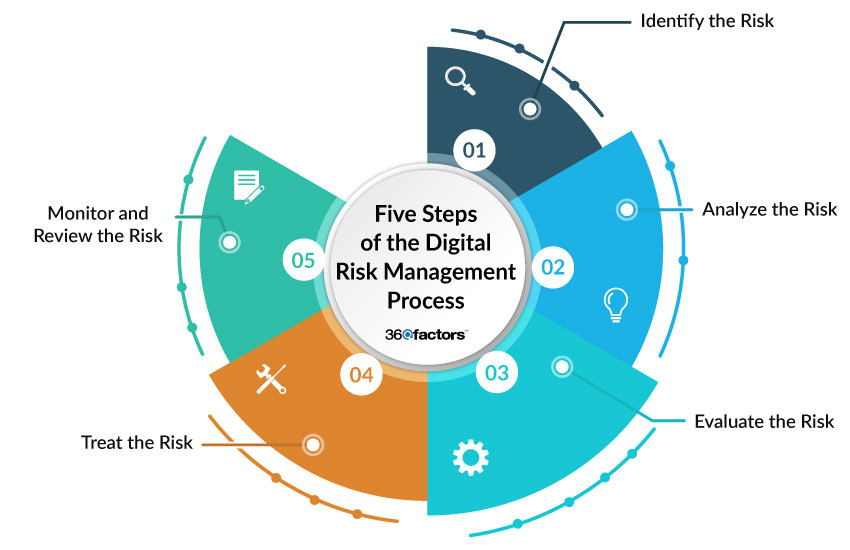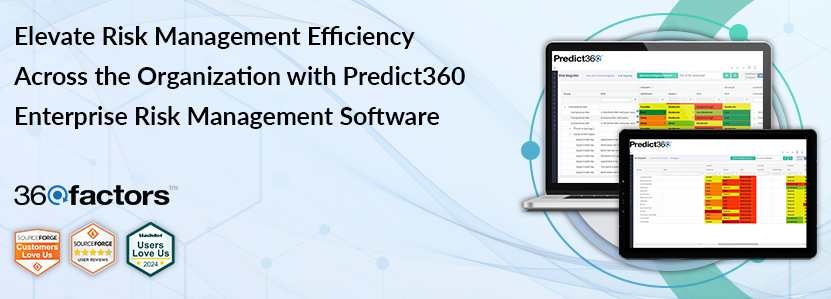Home/ Blog / Five Steps of the Risk Management Process 2025
Risk Management Process
The risk management process is a framework for the actions that need to be taken. There are five basic steps that are taken to manage risk; these steps are referred to as the risk management process. It begins with identifying risks, goes on to analyze risks, then the risk is prioritized, a solution is implemented, and finally, the risk is monitored. In manual systems, each step involves a lot of documentation and administration.
Here Are The Five Essential Steps of A Risk Management Process
- Identify the Risk
- Analyze the Risk
- Evaluate or Rank the Risk
- Treat the Risk
- Monitor and Review the Risk

Step 1: Identify the Risk
The initial step in the risk management process is to identify the risks that the business is exposed to in its operating environment.
There are many different types of risks:
- Legal risks
- Environmental risks
- Market risks
- Regulatory risks etc.
It is important to identify as many of these risk factors as possible. In a manual environment, these risks are noted down manually. If the organization has a risk management solutions employed all this information is inserted directly into the system.
The advantage of this approach is that these risks are now visible to every stakeholder in the organization with access to the system. Instead of this vital information being locked away in a report which has to be requested via email, anyone who wants to see which risks have been identified can access the information in the risk management system.
Learn in depth about risk identification
Step 2: Analyze the Risk
Once a risk has been identified it needs to be analyzed. The scope of the risk must be determined. It is also important to understand the link between the risk and different factors within the organization. To determine the severity and seriousness of the risk it is necessary to see how many business functions the risk affects. There are risks that can bring the whole business to a standstill if actualized, while there are risks that will only be minor inconveniences in the analysis.
In a manual risk management environment, this analysis must be done manually.When a risk management solution is implemented one of the most important basic steps is to map risks to different documents, policies, procedures, and business processes. This means that the system will already have a mapped risk management framework that will evaluate risks and let you know the far-reaching effects of each risk.
Step 3: Evaluate the Risk or Risk Assessment
Risks need to be ranked and prioritized. Most risk management solutions have different categories of risks, depending on the severity of the risk. A risk that may cause some inconvenience is rated lowly, risks that can result in catastrophic loss are rated the highest. It is important to rank risks because it allows the organization to gain a holistic view of the risk exposure of the whole organization. The business may be vulnerable to several low-level risks, but it may not require upper management intervention. On the other hand, just one of the highest-rated risks is enough to require immediate intervention.
There are two types of risk assessments: Qualitative Risk Assessment and Quantitative Risk Assessment.
Qualitative Risk Assessment
Risk assessments are inherently qualitative – while we can derive metrics from the risks, most risks are not quantifiable. For instance, the risk of climate change that many businesses are now focusing on cannot be quantified as a whole, only different aspects of it can be quantified. There needs to be a way to perform qualitative risk assessments while still ensuring objectivity and standardization in the assessments throughout the enterprise.
Quantitative Risk Assessment
Finance related risks are best assessed through quantitative risk assessments. Such risk assessments are so common in the financial sector because the sector primarily deals in numbers – whether that number is the money, the metrics, the interest rates, or any other data point that is critical for risk assessments in the financial sector. Quantitative risk assessments are easier to automate than qualitative risk assessments and are generally considered more objective.
Go in more depth Bringing Quantitative Risk Analysis to Enterprise Risk Management
Step 4: Treat the Risk
Every risk needs to be eliminated or contained as much as possible. This is done by connecting with the experts of the field to which the risk belongs. In a manual environment, this entails contacting each and every stakeholder and then setting up meetings so everyone can talk and discuss the issues. The problem is that the discussion is broken into many different email threads, across different documents and spreadsheets, and many different phone calls.
In a risk management solution, all the relevant stakeholders can be sent notifications from within the system. The discussion regarding the risk and its possible solution can take place from within the system. Upper management can also keep a close eye on the solutions being suggested and the progress being made within the system. Instead of everyone contacting each other to get updates, everyone can get updates directly from within the risk management solution.
Check our recent post: Improving Risk and Compliance Results With Smarter Data
Step 5: Monitor and Review the Risk
Not all risks can be eliminated – some risks are always present. Market risks and environmental risks are just two examples of risks that always need to be monitored. Under manual systems monitoring happens through diligent employees. These professionals must make sure that they keep a close watch on all risk factors. Under a digital environment, the risk management system monitors the entire risk framework of the organization. If any factor or risk changes, it is immediately visible to everyone. Computers are also much better at continuously monitoring risks than people. Monitoring risks also allows your business to ensure continuity.
We can tell you How you can create a risk management plan to monitor and review the risk.
The Basics of The Risk Management Process Stay the Same
Even under a digital environment, the basics of the risk management process stay the same. What changes is how efficiently these steps can be taken, and as it should be clear by now, there is simply no competition between a manual risk management system and a digital one. There are also many new risks that businesses are facing for the first time in 2025, and modern problems require modern solutions.
Risk Management Evaluation
Any business that wants to maximize its risk management efficiency needs to focus on risk management evaluations. These evaluations and assessments help businesses truly understand their own capabilities, strengths, and vulnerabilities. More evaluations result in more insights about where the business needs to improve its risk management framework. It can be difficult to carry out these evaluations manually, but risk management solutions and technology can simplify the evaluation and assessment workflow. It is important to do an evaluation before making any major changes to the risk management framework.
What is Risk Management?
Risk management is an important business practice that helps businesses identify, evaluate, track, and improve the risk mitigation process in the business environment. Risk management is practiced by the business of all sizes; small businesses do it informally, while enterprises codify it.
Businesses want to ensure stability as they grow. Managing the risks that are affecting the business is a critical part of this stability. Not knowing about the risks that can affect the business can result in losses for the organization. Being unaware of a competitive risk can result in loss of market share, being unaware of financial risk can result in financial losses, being aware of a safety risk can result in an accident, and so on.
Businesses have dedicated risk management resources; small businesses may have just one risk manager or a small team while enterprises have a risk management department. People who work in the risk management domain monitor the organization and its environment. They look at the business processes being followed within the organization and they look at the external factors which can affect the organization one way or the other.
A business that can predict a risk will always be at an advantage. A business that can predict a financial risk will limit its investments and focus on strengthening its finances. A business that can assess the impact of a safety risk can devise a safe way to work which can be a major competitive advantage.
If we think of the business world as a racecourse then the risks are the potholes which every business on the course must avoid if they want to win the race. Risk management is the process of identifying all the potholes, assessing their depth to understand how damaging they can be, and then preparing a strategy to avoid damages. A small pothole may simply require the business to slow down while a major pothole will require the business to avoid it completely.
Knowing the severity of a risk and the probability of risk helps businesses allocate their resources effectively. If businesses understand the risks that affect them then they will know which risks need the most attention and resources and which ones the business can disregard. Risk management allows businesses to act proactively in mitigating vulnerabilities before any major damage is incurred. There are different types of risk management strategies and solutions for different types of risks.
Read also: The Importance of Real Time Risk Appetite Tracking
Why is Risk Management Important?
Risk management is important because it tells businesses about the threats in their operating environment and allows them to preemptively mitigate risks. In the absence of risk management, businesses would face heavy losses because they would be blindsided by risks. If you want to see what risk management tools like Predict360 can do for your organization, simply sign up to get a live demo of Predict360’s most exciting features by getting in touch with us through chat, or request a demo.

About 360factors, Inc.
360factors, Inc. is a pioneering risk and compliance management technology company that empowers organizations with comprehensive, AI-driven solutions. Our flagship products, Predict360 and Lumify360, provide advanced capabilities for managing business performance and risk while ensuring regulatory compliance.
Predict360 integrates risk and compliance processes into a single, integrated GRC platform to streamline regulatory compliance, improve efficiency, and reduce risk while providing predictive insights and recommendations with advanced AI technology. For more information, visit www.360factors.com.
Request a Demo
Complete the form below and our business team will be in touch to schedule a product demo.
By clicking ‘SUBMIT’ you agree to our Privacy Policy.



